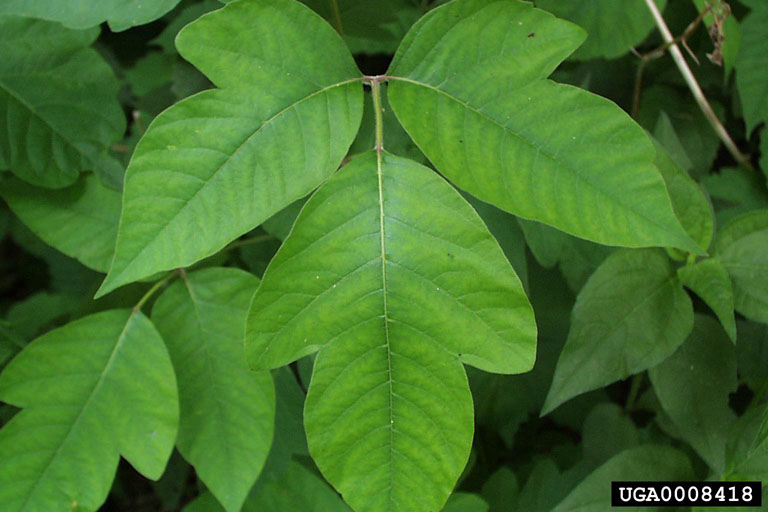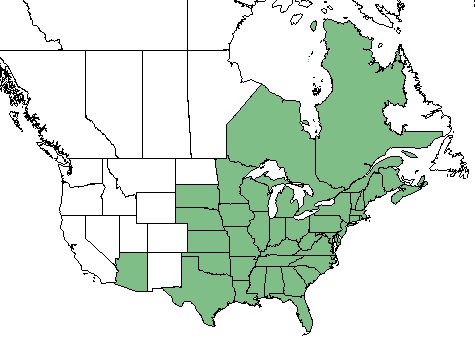Toxicodendron radicans
| Toxicodendron radicans | |
|---|---|

| |
| Photo by Paul Wray, Iowa State University, Bugwood.org hosted at Forestryimages.org | |
| Scientific classification | |
| Kingdom: | Plantae |
| Division: | Magnoliophyta - Flowering plants |
| Class: | Magnoliopsida - Dicots |
| Order: | Sapindales |
| Family: | Anacardiaceae |
| Genus: | Toxicodendron |
| Species: | T. radicans |
| Binomial name | |
| Toxicodendron radicans (L.) Kuntze | |

| |
| Natural range of Toxicodendron radicans from USDA NRCS Plants Database. | |
Common Name(s): Midwestern poison ivy[1], eastern poison ivy[1][2]
Contents
Taxonomic Notes
Varieties: T. radicans var. vulgaris (Michaux) A.P. de Candolle forma negundo (Greene) Fernald; T. radicans var. pubens; T. radicans var. radicans [1]
Description
Toxicodendron radicans is a dioecious perennial that grows in the form of a forb/herb, shrub, subshrub, or vine.[2] Leaves are deciduous, alternate, trifoliate, ovate with dentate margins and can change to a deep orange or red color in the fall. It requires partial to full shade. All parts of this plant are considered poisonous. Oils on the plant contain urushiol, a severe skin irritant, which can cause severe skin redness, itching, swelling and blistering following direct or indirect contact.[3] This toxicity is expected to increase as atmospheric CO2 levels increase.[4]
Distribution
It can be found from Texas north to South Dakota and Minnesota and in all of the states eastward. It has also been reported in southern Arizona and the Ontario and Quebec provinces of Canada.[2]
Ecology
Habitat
T. radicans is found throughout a wide range of habitats including mesic forests, rock outcrops, open areas, disturbed areas, xeric limestone sites, swamp forests, brackish marshes, bottomlands, maritime forests.[1] In a Mississippi study, T. radicans composed 7% of the understory biomass in a pine/hardwood habitat.[5] In New Jersey old field successional habitat, T. radicans's relative abundance was one of two dominant species after 14 years of succession.[6]
Phenology
T. radicans has been observed flowering March to May with fruits appearing in August through October.[1][7] Flowers can contain colors of white, green and/or brown. Fruits are amber in color and 0.25 in (6.4 mm) in diameter.[3]
Fire ecology
Selective herbicides and a three year fire frequency over a period of 10 years did not significantly impact the biomass of T. radicans.[5]
Pollination
In Iowa, T. radicans was observed being pollenated by 37 different floral associates consisting of coleopterans (beetles), dipterans (flies), hemipterans (true bugs), hymenopterans (ants, bees, wasps), and lepidopterans (butterflies). This diverse assemblage may partially explain its success across varied habitats.[8]
Use by animals
T. radicans attracts butterflies and is highly resistant to deer herbivory.[3] It comprises 10-25% of the diet of large mammals and 5-10% for small mammals and terrestrial birds.[2] Humans use the urushiol compounds of T. radicans to test the efficacy of skin protectant against chemical warfare agents.[9]
Conservation and Management
Cultivation and restoration
Photo Gallery
References and notes
- ↑ 1.0 1.1 1.2 1.3 1.4 Weakley A. S.(2015). Flora of the Southern and Mid-Atlantic States. Chapel Hill, NC: University of North Carolina Herbarium.
- ↑ 2.0 2.1 2.2 2.3 USDA, NRCS. (2016). The PLANTS Database (http://plants.usda.gov, 20 December 2017). National Plant Data Team, Greensboro, NC 27401-4901 USA.
- ↑ 3.0 3.1 3.2 Plant database: Toxicodendron radicans. (20 December 2017).Lady Bird Johnson Wildflower Center. URL: https://www.wildflower.org/plants/result.php?id_plant=TORA2
- ↑ Mohan J.E., Ziska L. H., Schlesinger W. H., Thomas R. B., Sicher R. C., George K., and Clark J. S. (2006). Biomass and toxicity responses of poison ivy (Toxicodendron radicans) to elevated atmospheric CO2. Proceedings of the National Academy of Science of the United States of America 103(24):9086-9089.
- ↑ 5.0 5.1 Iglay R. B., Leopold B. D., Miller D. A., and Burger, Jr. L. W. (2010). Effect of plant community composition on plant response to fire and herbicide treatments. Forest Ecology and Management 260:543-548.
- ↑ Myster R. W. and Pickett S. T. A. (1990). Initial conditions, history and successional pathways in ten contrasting old fields. American Midland Naturalist 124(2):231-238.
- ↑ Nelson, G. PanFlora: Plant data for the eastern United States with emphasis on the Southeastern Coastal Plains, Florida, and the Florida Panhandle. www.gilnelson.com/PanFlora/ Accessed: 20 DEC 2017
- ↑ Senchina D. S. and Summerville K. S. (2007). Great diversity of insect floral associates may partially explain ecological success of poison ivy (Toxicodendron radicans subsp. negundo [Greene] Gillis, Anacardiaceae). The Great Lakes Entomologist 40(3-4):120-128.
- ↑ Liu D. K., Wannemacher R. W., Snider T. H., and Hayes T. L. (1999). Efficacy of the topical skin protectant in advanced development. Journal of Applied Toxicology 19(supp 1):S41-S45.